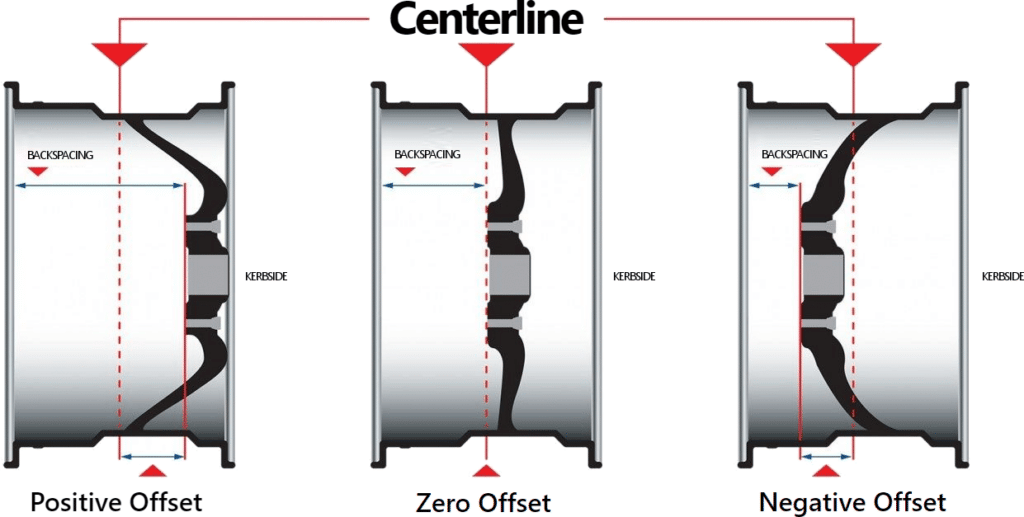Simple modifications can do a lot for your car. For instance, reducing the ride height helps improve handling by lowering the center of gravity. Installing lighter wheels reduces unsprung weight, and using wider tires significantly enhances traction.
Similarly, installing wheel spacers or low offset rims can help to increase the track width of your car, effectively reducing body roll and improving stability. This of course depends on a few fitment-related parameters.
It’s fascinating how much your driving dynamics can change with this small yet effective upgrade; not to mention the added visual appeal.
While we acknowledge ride height and unsprung weight to be important and equally interesting subjects, what we’re really focussing on is track width.
In this article, we’ll discuss what is track width, how it affects handling, and how to measure it yourself.
Track Width Definition

Wheel track or track width is the distance between the centerline of two wheels on the same axle. Some might confuse it with axle track, which is the distance between the hub flanges on an axle.
In most scenarios, wheel track and axle track are the same length. However, in the case of offset wheels, the two differ. Mainly because the centreline of the wheel doesn’t align with the hub flange, irrespective of whether it’s a positive or negative offset.
To put it simply, if you’re running offset wheels, your tire centerline won’t align with the hub flange. So installing offset wheels will change the wheel track but the axle track won’t change.

Wheel track width affects the lateral and diagonal weight transfer of a car. The longer the track width, the more stable the car is around corners.
It also affects the dynamics of the car. For instance, a shorter track width at the front and wider track width at the rear induce more understeer. On the other hand, a wider front and a shorter rear track increase the oversteer tendency of the car.
Wide Wheel Track: Advantages and Disadvantages
Now let’s go over some of the advantages of having a wider wheel track. Firstly, a wider track will make the springs feel weaker since you will be using a longer lever on them. So a wider front track will make the front suspension feel softer, reducing understeer.
When we discussed dynamics, we said a wide front plus a short rear tends to induce oversteer. Why is it so? A wider track on one end of the car rather than the other will affect the way load is transferred when cornering.
A wider front track will tend to reduce load transfer to the outside when cornering, which increases cornering ability since you’ll be able to get more traction from the inside tires. A shorter rear track results in a relatively quicker weight transfer, making the car oversteer.
Now let’s talk aesthetics. Having a wider wheel track means a better stance. Pair that to a lowered ride height and it all looks rather sporty and muscular. But mind you, it’s not all sunshine and rainbows.

Widening the track through safe use of wheel spacers does several other things to the car’s suspension geometry.
It increases the front scrub radius, which leads to more steering effort. Having a wider track also affects the steering feel and kickback.
With more scrub radius, there’s more kickback, meaning your steering will be more sensitive to directional changes every time it hits a pothole.
A wider track can increase the stress on the suspension bearings. The load will be cantilevered further out than the suspension’s maximum tolerance.
Lastly, having a wider track increases the turning radius as the wheels now have to travel further to cover the same distance.
Also, it’s important to maintain an optimum ratio between the front and rear tracks as a means to manage the load transfer from the front to the back. If the ratio is off, expect the car to handle awkwardly, defeating the purpose of this whole exercise.
Measuring Track Width
When it comes to measuring track width, it’s fairly simple. Place your car on a level surface with the handbrake fully engaged.
Turn the steering wheel so the front wheels point straight. Now using the tape, measure the distance between the axle. Start by placing one end of the tape on the outside tread of the tire while placing the other end on the inside tread of the opposite tire.
You can also measure end to end; just make sure to subtract the tread width from your measurement to get the exact wheel track.

Summary
Understanding what wheel track is and how it affects ride quality is important, especially if you’re considering a widebody kit.
Most car modifications, particularly those involving wheels and suspension, can bring about unintended changes in the way your car drives. Being mindful of this will go a long way.
Have you considered extending your wheel track width? Let us know in the comments below!


2 comments
You can’t measure track or any other suspension variable with the car jacked up or on stands, the car needs to be at normal ride height.
You need to measure on the fronts of the wheels and then the backs of the wheel and take the average; otherwise the toein/toeout will take away from accuracy.